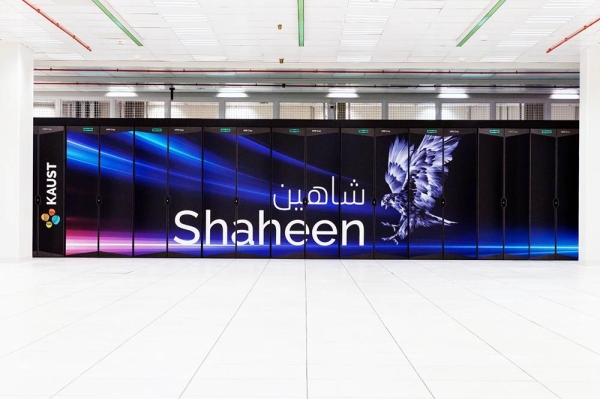
TOP500, the definitive voice of supercomputer statistics, has Tuesday confirmed King Abdullah University of Science and Technology (KAUST) operates the Middle East’s most powerful supercomputer, Shaheen III, with key details about its capabilities revealed at SC23, the international conference for supercomputing. Shaheen III is also ranked 20
th in the world rankings.
Built by the world’s leading supercomputer provider, Hewlett Packard Enterprise (HPE), Shaheen III is about six times faster than KAUST’s existing Shaheen II system, with its processing power exceeds that of 500,000 latest-generation MacBook Pros operating in concert.
Based on the HPE Cray EX supercomputer, which also powers three of the world’s top 10 systems, Shaheen III is architected to support unprecedented performance and scale.
KAUST will operate Shaheen III to support the construction and testing of predictive mathematical models using traditional simulations based on differential equations, emulation based on statistics and machine learning based on neural networks.
These mathematical models can be employed in the service of many things, including scientific discovery, engineering design and policy support.
“Shaheen III takes KAUST’s world-class research capabilities to the next level through its processing power and ability to create models across many fields in a short period of time” said Dr. Tony F. Chan, president of KAUST.
“Shaheen III will be crucial in supporting sustainability campaigns related to our National Center for Climate Change and for national projects that align with the Kingdom’s Vision 2030, helping to accelerate Saudi Arabia’s growth in areas such as sustainable development.”
Professor David Keyes, KAUST’s founding Dean, added: “Supercomputing is part of KAUST’s research and curricular DNA, with many of our faculty recruited around supercomputing.
“Computational approaches formerly lagged theoretical, observational, and experimental approaches. Now, more often than not, they lead because of supercomputers like Shaheen III.”
In its first phase, Shaheen III will be deployed to superpower research across many fields contributing to sustainability goals, such as campaigns in materials, catalysis, combustion of alternative fuels, carbon sequestration and bioinformatics.
Shaheen III will be able to create models at high resolution in areas including atmospheric and ocean dynamics and aerodynamics engineering, including for Formula 1 vehicles, for example.
Shaheen III will also provide advanced noninvasive imaging for areas such as the discovery of petroleum reservoirs, medical imaging and the nondestructive evaluation of structures.
“We are proud to partner with KAUST to accelerate its world-class research in fields such as climate change, clean energy and life sciences and to celebrate their achievement,” said Trish Damkroger, senior vice president and chief product officer, HPC, AI & Labs at HPE.
“Research universities like KAUST are increasingly putting supercomputers at the heart of their curriculum because modeling, simulation, machine learning and AI capabilities are fundamental to scientific discovery and innovation.”
Shaheen III’s full program is on track to deliver by the end of 2024. As one of the world’s leading supercomputing centers, KAUST is building on the success of its first supercomputer, Shaheen I, launched in 2009, followed by Shaheen II, a HPE Cray EX supercomputer that is 25 times faster than its predecessor at 5.54 petaflop/s.
Over 66% of KAUST’s faculty groups currently engage in supercomputer activity on Shaheen II, with the percentage working with Shaheen III expected to be even higher. — SG












